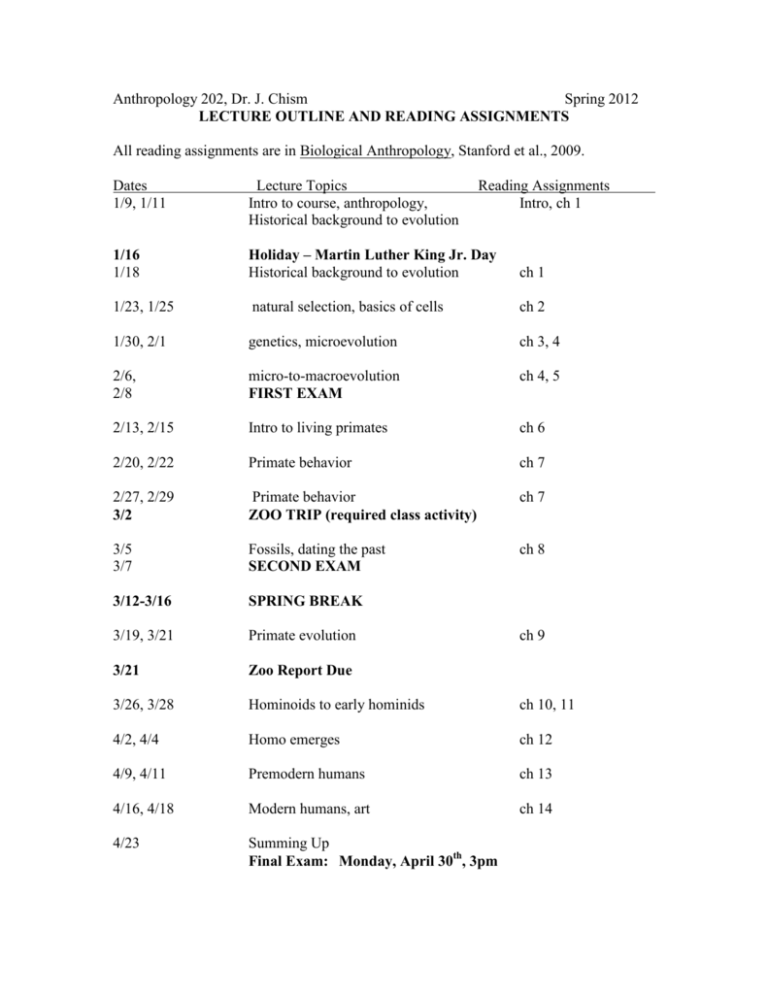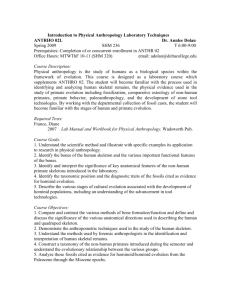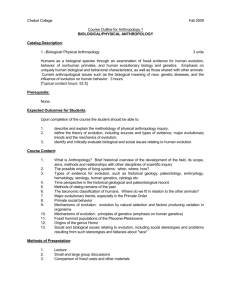ANTH 202 001 Intro to Biological Anthropology
advertisement

Anthropology 202, Dr. J. Chism Spring 2012 LECTURE OUTLINE AND READING ASSIGNMENTS All reading assignments are in Biological Anthropology, Stanford et al., 2009. Dates 1/9, 1/11 Lecture Topics Intro to course, anthropology, Historical background to evolution Reading Assignments Intro, ch 1 1/16 1/18 Holiday – Martin Luther King Jr. Day Historical background to evolution ch 1 1/23, 1/25 natural selection, basics of cells ch 2 1/30, 2/1 genetics, microevolution ch 3, 4 2/6, 2/8 micro-to-macroevolution FIRST EXAM ch 4, 5 2/13, 2/15 Intro to living primates ch 6 2/20, 2/22 Primate behavior ch 7 2/27, 2/29 3/2 Primate behavior ZOO TRIP (required class activity) ch 7 3/5 3/7 Fossils, dating the past SECOND EXAM ch 8 3/12-3/16 SPRING BREAK 3/19, 3/21 Primate evolution 3/21 Zoo Report Due 3/26, 3/28 Hominoids to early hominids ch 10, 11 4/2, 4/4 Homo emerges ch 12 4/9, 4/11 Premodern humans ch 13 4/16, 4/18 Modern humans, art ch 14 4/23 Summing Up Final Exam: Monday, April 30th, 3pm ch 9 INTRODUCTION TO BIOLOGICAL ANTHROPOLOGY (ANTH 202/001:3) CRN# 21125 Spring 2012 Lecture MW 12:30-1:45, Lab 2:00-3:15, 333 Dalton Hall Dr. Janice Chism & Ms. Jessica Boulware Contact Information for Dr. Chism: Office Hours: TRF10:00-11:00 and by appointment, 118 Dalton. Office Phone/Voicemail: 323-2111 ext 6429. Email: chismj@winthrop .edu Contact Information for Ms. Boulware: Office Hours: MW 11-12 and by appointment, 106 Dalton. Office Phone/Voicemail: 323-2111 ext. 6435. Email: boulwarej@winthrop.edu Textbook: Biological Anthropology: The Natural History of Humankind, Stanford, Allen and Antón, 2nd ed. 2009, and Lab Manual and Workbook for Physical Anthropology, 7th ed., Diane France, 2011. Scope and Purpose of the Course: This course traces the evolutionary history of humans and their primate relatives. We will study the anatomy, physiology and behavior of living and fossil primates, look at the extent of variation among modern humans and examine the evidence for the morphology and ways of life of our hominid ancestors. Labs are designed to familiarize students with the scientific method and to provide handson experience with key concepts and with skeletal and fossil material. Student Learning Outcomes and General Education Goals: This course is designed to meet Goal 5 – To understand scientific knowledge in terms of its methods or acquisition, its specific quantitative nature, and its dynamic and contingent character. It fulfills the General Education Life Sciences Lab Course requirement. To meet the criteria for these classes the course must include a significant writing and critical thinking component and opportunities for students to collect and analyze original data. The course is designed to meet Objectives 1, 2, 3, 4 and 6 of the Natural Science Component. Students in this course learn fundamental concepts in life science related to evolution, genetics, human and nonhuman primate skeletal functional anatomy, human biology and adaptation to diverse environments, paleoanthropology, behavior and ecology of primates (Objective 1). Students carry out short original investiations in which they collect and anlalyze data and then write up conclusions, demonstrating that they understand and can apply scientific methods of inquiry and that they can defend conclusions based on their own observations (Objectives 2, 6). They will be able to discuss strengths and limitations of biological anthropology as a science. Students will also be able to demonstrate an understading of the history of scientific discovery in the life sciences generally and biological anthropology specifically (Objectives 3, 4). Course Requirements: There will be two in-class lecture exams, three lab quizzes, two written reports, a lab practical exam and a comprehensive final exam. There will also be one required Friday afternoon field trip to Riverbanks Zoo. Information on the reports will be provided in separate handouts. Students are responsible for all material whether covered in lectures and labs or assigned as readings. Exams will include material from readings, films, lab demonstrations, the field trip, and class discussions as well as lecture material. Grading and Point Distribution: In-class exams: 2 @100 pts each = 200 pts Lab, Zoo Report: 25, 50 pts = 75 pts Lab quizzes: 3 @ 25 pts each = 75 pts Lab Practical = 50 pts Final Exam = 150 pts Total = 550 pts Grading will be based on the following scale: 93-100% A 83-87% B 73-77% C 92-90% A80-82% B70-72% C88-89% B+ 78-79% C+ 68-69% D+ 60-67% D below 60% F Standards for Grading Written Work: To receive an A, written work, including reports and essays, must reflect an excellent grasp of the subject matter and must be free of grammatical and spelling errors. Work that meets all of the criteria of the assignment but shows no special effort or understanding of the material, or, work that has more than a few typographical or grammatical errors is C quality work at best. Academic Honesty: As members of the Winthrop academic community we have all pledged to adhere to the Winthrop Code of Academic Honesty. This code and what constitutes an act of academic dishonesty can be found in the Student Handbook. I expect students in my classes to be familiar with the code and to abide by it. Academic dishonesty is grounds for receiving a failing grade in this class. In addition, it is my policy to report any act of academic dishonesty including plagiarism to the Dean of Students for possible additional action. Plagiarism, use of others’ words or ideas without full and appropriate citation, is a serious act of academic dishonesty. What constitutes plagiarism is carefully and fully defined in the Prentice Hall Reference Guide to Grammar and Usage, pp. 298-301, the reference required for all university WRIT 101 courses. Excellent on-line sources of help in identifying and avoiding plagiarism and correctly citing borrowed information can be found at the Biology Department’s website under Academic Integrity (www.winthrop.edu/biology/academic/academicintegrity.htm) at the Dacus Library website (www.winthrop.edu/dacus/About/Infoguides/plagiarism.htm) and the Writing Center website (www.winthrop.edu/wcenter/wcenter/dontplag.htm). Students are responsible for reviewing this material carefully, abiding by it in all assignments presented for a grade, and asking for clarification and assistance well before any assignments are due if they do not understand what is required. Written assignments will be evaluated for appropriate use of borrowed information using the plagiarism detection web service, Turnitin.com. Attendance and Success in the Course: Regular attendance is crucial to success in this course. Some material will only be presented in class or labs (for example, skeletal material, fossils, films). In addition, some scientific concepts are most easily learned with direct, hands-on experience. This course has a required lab designed to provide you with this kind of experience. Students are responsible for the consequences of all absences and for meeting all of the requirements of the class. Make-Ups and Late Work: Make-up exams will be given ONLY in the event of serious illness specifically verified by a physician, in writing. In general, it will not be possible to make up lab quizzes or practical exams. Work turned in late will lose 10% of the total available points per day late (including weekend days). Projects turned in without all of the required material or not submitted to Turnitin.com will be counted late and penalized appropriately. Classroom Etiquette: Cell phones, pagers, cd players and all other forms of electronica are not permitted in this class at any time. If I see or hear one of these, I will ask it and you to leave for the day. Permission of the instructor is required for any photography or audio recording in class. Students with Disabilities: If you have a disability and need classroom accommodations, please contact Gena Smith, Coordinator, Services for Students with Disabilities, at 323-3290 as soon as possible. Once you have your notification letter, please let me know so that I am aware of any accommodations needed well before the first test, paper or assignment. Syllabus Change Policy: Once the course begins changes to the syllabus or schedule of course activities will only be made in case of extreme circumstances (such as a major weather event or family emergency) beyond my control. If any change in the syllabus or schedule of course activities becomes necessary I will notify students as soon as possible via email and will provide a revised schedule of activities if needed. Biological Anthropology: Laboratory Schedule-- Spring 2012 Readings and exercises in Lab Manual &Workbook for Physical Anthropology Week/Dates #1: 1/9, 1/11 Topics& Activities Intro, Sci. method #2: 1/16, 1/18 Evolution and Darwin # 3: 1/23, 1/25 Cells Handout #4: 1/30, 2/1 Mitosis & meiosis; Mendelian genetics (Do ex 1.3) ch 1 (p.1-6) ch 1 #5: 2/6, 2/8 Human genetics, ABO blood groups (Do ex. 1.5) population genetics ch 1 (21-22) ch 1 (p. 25-27) #6: 2/13, 2/15 How selection works: Assortative Mating Project ; taxonomy & primate classification Lab Quiz I: Genetics handout handout #7: 2/20, 2/22 comparative mammalian anatomy; living primate characteristics (Do ex. 5.1, 6.1) ch 5 (111-127) ch 6 #8: 2/27 2/27, 2/29 Assortative Mating Project Due Primate behavior; observing primates, video ZOO TRIP (do 7.1, 7.2, 7. 3 at zoo) 2/15 3/2 Lab Manual Handout ch 7 #9: 3/5 3/5, 3/7 Lab Quiz II: Primates human osteology (Do ex. 3.1) #10: 3/12, 3/14 SPRING BREAK #11: 3/19, 3/21 Osteology: Skulls, teeth and diets; forensics ch 8 ch 14 #12: 3/26, 3/28 3/28 Fossil primates (Do ex. 8.1); Lab Quiz III: The skeleton; ch 8, 9 #13: 4/2, 4/4 Early hominids (Do ex. 9.1) Australopithecus to Homo ch 10 #14: 4/9, 4/11 Homo (Do ex. 11.1); Modern humans, ch 11 #15: 4/16, 4/18 Brain evolution, tools; review 4/23 Lab Practical ch 3






